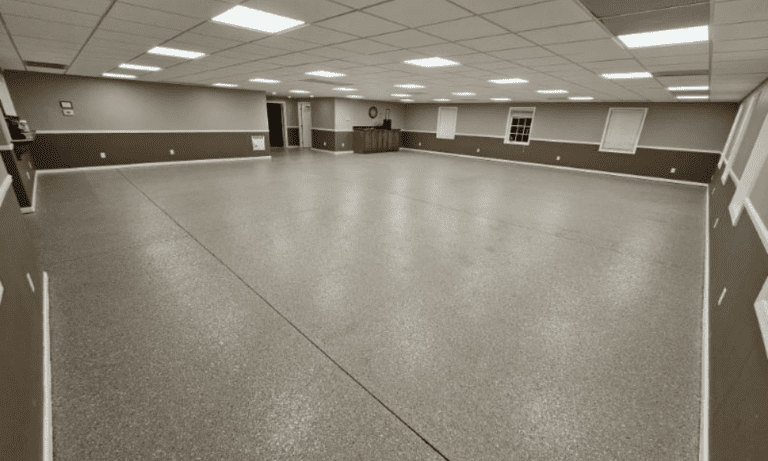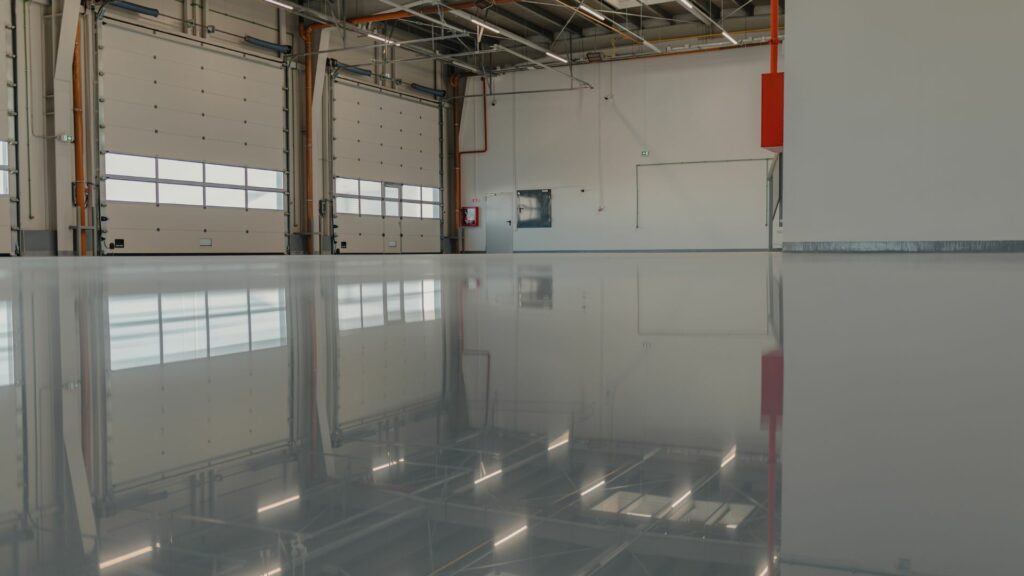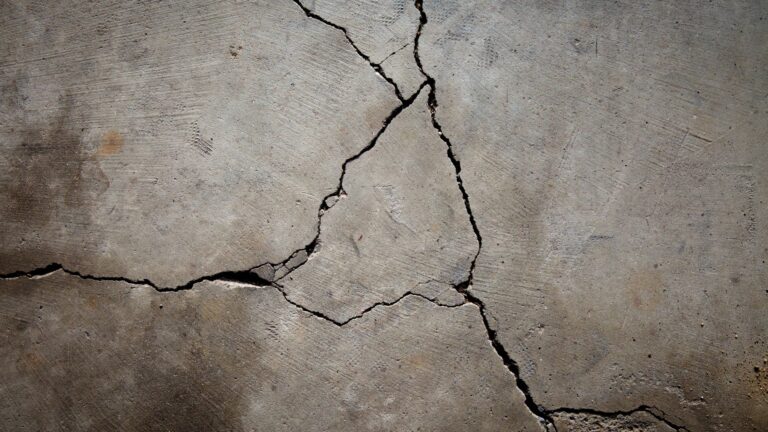If you are looking into coatings for your home or business and wondering why concrete floors crack, you are not alone. Homeowners in Huntsville and facility managers from Madison to Decatur see hairlines or wider splits and want to know what they mean, what to fix, and which coating system will last. If you have searched for epoxy floors near me, Rocket City Epoxy can help you read the slab, repair it the right way, and choose a finish that fits how your floor actually performs.
Concrete is a strong, durable material, yet it moves with temperature and moisture. When that movement is restrained or concentrated, the slab relieves stress by cracking. The key is understanding which cracks are harmless, which require repairs, and how to prevent future cracking before you invest in an epoxy floor coating, a garage floor coating, or fast curing polyaspartic floors.
What Concrete Cracking Really Means
Cracks are a symptom, not a verdict. They show how the slab moved, where it was restrained, and how well joints and curing were handled. Read the crack the way a mechanic reads a gauge, then choose the right repair before you install an epoxy floor coating, a garage floor coating, or fast-return polyaspartic floors.
Plastic shrinkage cracks show up soon after pouring when the surface dries too fast, drying shrinkage cracks appear as hairlines over weeks and months, settlement cracks follow pipes or thickness changes, thermal cracks are straighter and wider near sunny edges, and joint-related cracks happen when control joints are missing, cut late, or spaced too far apart. What matters most is width and movement: stable hairlines can usually be chased and filled, but moving or stepped cracks need purpose-built repairs like flexible or semi-rigid fillers, stitching, or structural epoxy injection.
Before any epoxy floor coating, garage floor coating, or polyaspartic floors install, map the cracks, check for moisture issues, match the repair to the behavior, then pick the system that fits the slab and sun exposure (many homeowners choose polyaspartic garage floors for fast return and UV stability). Coatings do not stop concrete from moving, so good jointing, repairs, and surface prep are what prevent reflective cracking later.

Crack Clues You Can Spot in Seconds
When did it appear?
Hours after placement points to plastic shrinkage. Weeks or months later often means drying shrinkage. Large day-night swings or sun at the garage door suggest thermal movement.
How wide is it and does it move?
Hairlines that do not change width are often cosmetic. Cracks that open and close with seasons, or show any vertical step between sides, need evaluation and a repair that can handle movement. ACI guidance emphasizes identifying cause and activity before selecting repair methods.
Where is it?
Through a re-entrant corner, along wheel paths, or right where a control joint should have been usually signals restraint or jointing issues. As a rule of thumb, slabs without timely joints or with joints spaced too far apart are prone to random cracking.
What pattern do you see?
Parallel, shallow lines soon after pour = plastic shrinkage. Random hairlines over big panels = drying shrinkage. Straight, wider lines tied to sun or heat = thermal. Over pipes or thick-to-thin transitions = settlement.
Why Concrete Floors Crack
1) Shrinkage plus restraint
Concrete shrinks as it dries. If that shrinkage is restrained by subgrade friction, walls, columns, or re-entrant corners, tensile stress builds until the slab cracks. Good curing and the right joint plan reduce early age cracking.
2) Temperature change
Concrete expands when warm and contracts when cool. Sun at a garage door, daily temperature swings, and heat of hydration create gradients that drive cracking unless joints and details let the slab move.
3) Joints that are missing, mistimed, or spaced too far
Control joints are planned weak planes that tell the slab where to crack. Many industry references point to spacing on the order of 24 to 36 times the slab thickness in inches for unreinforced slabs on grade, with timely saw cuts to prevent random cracking. Closer spacing reduces risk.
4) Subgrade support
Soft spots, poor compaction, or abrupt thickness changes concentrate stress and often show up later as settlement cracking.
5) Loads and use
Point loads from racks, hard wheels, jacks, or dropped tools can open dormant cracks or start new ones, especially on thinner residential slabs. Matching the coating system and joint filler to the traffic is essential.
6) Moisture vapor drive
Moisture moving through a slab can create blisters, pinholes, or debonding in coatings and can aggravate microcracking. Pre-installation testing and breathable or tolerant systems help prevent issues.
When To Act
If a crack is a true hairline with no vertical displacement and has remained unchanged for several months, it is generally safe to repair and proceed with your epoxy floor coating or garage floor coating. However, if the crack runs long distances, changes width with the weather, crosses multiple panels, or appears at a re-entrant corner, it is best to pause for a professional evaluation. Before installing any system, confirm slab moisture using the in-situ RH method outlined in ASTM F2170 to prevent blisters or bond failures. Stable hairlines can typically be chased and filled, while moving cracks may require flexible or semi-rigid fillers or stitching, and clean, inactive structural cracks can be bonded with epoxy injection as summarized by ACI 224.1R. Once repairs are complete, choose the finish that suits your space and sunlight exposure. Many homeowners prefer polyaspartic floors or polyaspartic garage floors for their fast return to service and excellent UV stability.
Where Cracks Are Most Likely to Appear
Garage door lines and aprons
This is the hottest, most stressed strip of a slab. Afternoon sun heats the edge, evening air cools it, and hot tires twist and load the concrete. That combination drives thermal movement and small surface shears that often start hairlines right at the door. We repair those first, then recommend a build that handles sun and traffic, typically an epoxy base for body and adhesion with a UV stable polyaspartic topcoat. For fast turnarounds, many homeowners choose full polyaspartic garage floors so they can park sooner and avoid yellowing at the threshold.
Basements and open rooms
Big, open panels are prone to drying-shrinkage hairlines, especially if joints were spaced too far or cut late. These cracks are usually cosmetic and can be routed, filled, and hidden under an epoxy floor coating. If moisture is present, we adjust primers or mitigation so your finish bonds well and resists future telegraphing.
Warehouses, labs, schools, and churches
Sawcut joints and column lines concentrate movement. Hard-wheeled traffic and point loads can open edges if joints are unprotected. Our approach is to repair cracks, install semi-rigid joint fillers where appropriate, then use a durable build such as an epoxy body coat with a polyaspartic topcoat. That combination delivers abrasion resistance, chemical resistance, and a quick return to service that keeps operations moving.
Local exposures around Huntsville
High-traffic destinations and sun-facing bays see more movement. Door aprons near Town Madison and Toyota Field handle frequent parking, turning, and tailgates, so reflective cracking is common unless joints and repairs are dialed in. Busy shop areas serving Redstone Arsenal and service corridors around the U.S. Space & Rocket Center see heavy carts and daily temperature swings, so joints and coatings must be matched to use. The MidCity District mixes retail, dining, and entertainment, which means lots of foot and vehicle traffic near exterior doors. In these sunlit zones, polyaspartic floors help maintain color and handle wear, while epoxy provides a strong base.
In short, the places cracks show up most often tell you how to finish them: sun-exposed thresholds and door aprons do best with UV-stable polyaspartic floors or full polyaspartic garage floors for quick return to service, large interior panels need smart joint layout plus repair before an epoxy floor coating, and high-traffic commercial zones benefit from semi-rigid joint fillers with an epoxy body coat topped by polyaspartic for durability and uptime. No matter the location, we map the cracks, repair first, mechanically grind for bond, and then match the build to your light, load, and moisture conditions so your garage floor coating or interior system looks great and lasts.

Who to Call for Crack Repair
We take the time to really understand your floor before any work begins. Our process starts with reading the slab, carefully checking its condition to spot and repair cracks, seal joints, and ensure the surface is fully prepared for the best results. From there, we guide you in choosing the right solution for your space, whether that’s the durability and timeless style of an Epoxy Floor Coating, the quick turnaround of a fast return to service polyaspartic system, or exploring our custom blends on the Floor Finishes page.
Every floor we install is matched to your slab, your space, and your schedule.
How We Prevent and Fix Cracking Before We Coat
Plan the joints
A smart joint layout breaks large panels into smaller, predictable sections. We review thickness, shape, and re-entrant corners, then cut on time. Joints reduce random cracking by giving the slab a controlled path for movement.
Cure the slab
Proper curing lowers early shrinkage and improves durability. Even if your slab is older, knowing how it was cured helps us predict where cracks might appear and how to repair them. NRMCA resources explain why curing and joining matter.
Repair what is there
- Routing and sealing for dormant hairlines.
- Semi-rigid fillers to protect saw cuts and traffic joints under hard wheels.
- Stitching or epoxy injection where a clean, inactive structural crack needs load transfer.
Mechanical surface prep
We mechanically grind to open the concrete, remove weak paste, and create an even profile for deep bonds.
Choose the right coating build
- Epoxy floor coating. Excellent chemical resistance and a solid foundation for decorative flakes. Ideal for shops, basements, and many commercial spaces. Polyaspartic floors. Rapid cure, UV stability, high abrasion resistance, and an easier return to service. Great for sunny garage door lines and busy facilities. Details on our Polyaspartic Flooring page.
Polyaspartic garage floors. A customer favorite for one-day turnarounds, hot tire resistance, and color stability at door aprons that see full sun.
What Locals Say about Working With Us
Customers across Huntsville, Madison, and Athens mention quick communication, neat crews, and coatings that look great and clean easily. Homeowners appreciate one-day installation for polyaspartic garage floors, the tidy grind-and-vac process, and clear advice about joints and crack repairs. Commercial managers highlight less downtime, bright reflective floors that improve lighting, and durable surfaces that handle carts and hard wheels without constant touch ups.
Here Are Some Common Things You Might be Curious About
1) Are hairline cracks normal in concrete?
- Yes, hairline cracks are common as concrete dries and shrinks. With a thoughtful joint plan and proper curing you can reduce them, but a few hairlines do not usually mean a structural problem. Before coating, we chase and fill these so they will not telegraph through your finish.
2) Will an epoxy or polyaspartic system hide cracks completely?
- Repair plus coating can disguise many hairlines, but if a crack remains active, it can reflect through even a quality system. The solution is to identify the cause, repair accordingly, and select a system that fits your slab conditions. For sunny doorways, a polyaspartic topcoat adds UV stability that helps the finish keep its color.
3) What is the best coating for a cracked garage slab?
- For most garages, we recommend a build that uses an epoxy base for body and a polyaspartic topcoat for rapid cure and UV stability. If you want maximum speed, some projects are full polyaspartic garage floors. If your slab has significant movement or moisture, we adjust the build and joint fillers to match.
4) How do control joints help with cracking?
- Control joints create a planned weak plane so the slab can relieve shrinkage in a straight, predictable line. The spacing rule of thumb for unreinforced slabs is often in the range of two to two and a half times the slab thickness in inches when converted to feet, with timely saw cuts to avoid random cracking. Tighter spacing reduces risk.
5) I see cracking near my garage door. Is that normal?
- Yes, the garage door line is a high movement zone. Sun heats the slab edge, then evening cooling contracts it. Add hot tire loads and turning wheels, and you get more stress at that joint. We pay special attention to this area with repairs, joint fillers, and UV stable topcoats.
6) Can you coat over old patching or previous coatings?
- Usually, yes. We test adhesion, mechanically grind to a clean profile, remove weak patches, and repair cracks and spalls with compatible materials. Honest evaluation is critical. If something will not last under a new system, we remove it and rebuild the area first.
7) What if my cracks change width during the year?
- Seasonal movement means the crack is active. We evaluate width change, location, and subgrade conditions, then choose a repair that accommodates movement. In some cases we honor that line as a joint through the coating to prevent reflective cracking.
8) How fast can I return to service?
- Epoxy systems typically need more cure time before heavy traffic. Polyaspartic floors cure quickly, so many residential garages are ready the next day. We will give you a clear schedule at install so you know exactly when to walk, move items, and park.
9) Is moisture a problem for coatings?
- Moisture vapor can cause blisters or debonding. We assess the slab, choose appropriate primers or mitigation steps, and, if needed, design a build that tolerates measured vapor levels. Catching this early avoids callbacks and protects your investment.
10) Do you work in my part of North Alabama?
- Yes. We regularly serve Huntsville, Madison, Athens, Decatur, and nearby communities. See our pages for Huntsville and Tuscaloosa or contact us with your address and we can confirm.
If you have more questions, visit our FAQ page for additional information or get in touch with us directly.

Why Choose Rocket City Epoxy for Coating a Cracked Slab
Experience with Repairs
We never just cover cracks. We fix them the right way before we start coating. Our team uses the right repair methods for each situation, whether that means sealing joints, filling with flexible products, or using epoxy injection. This gives your new floor a solid base that will last.
Clear Communication
We give you honest answers about your slab’s condition, what needs to be fixed, and what can be left alone. You’ll know exactly what we’re doing and why, so you can feel confident in your choices.
Systems That Match Your Space
Every space is different, so we match the system to your needs. Epoxy builds offer strong chemical resistance, polyaspartic floors install quickly and hold up to sunlight, and hybrid systems combine the best of both.
Design Options
Your floor can be both tough and good-looking. On our Floor Finishes page, you can explore dozens of colors and blends to match your style and space.
Local Focus
We know North Alabama weather, the way the sun hits garage door lines, and the weight demands of garages, shops, and warehouses. This local knowledge helps us build floors that stand up to the conditions here.
Making the Right Choice for Your Floor
Concrete will always move, and with that movement, cracks can form. The key is knowing how to work with it, not against it. That means guiding movement with proper joints, repairing flaws the right way, and installing a floor coating designed for your slab. Whether you’re drawn to the classic look and durability of epoxy, the quick turnaround of polyaspartic, or a garage floor coating that adds lasting value to your home, we’ll make sure it’s done right from the start. Our goal is to give you a floor that not only looks great on day one but stays strong and beautiful through years of use, weather changes, and daily wear.

